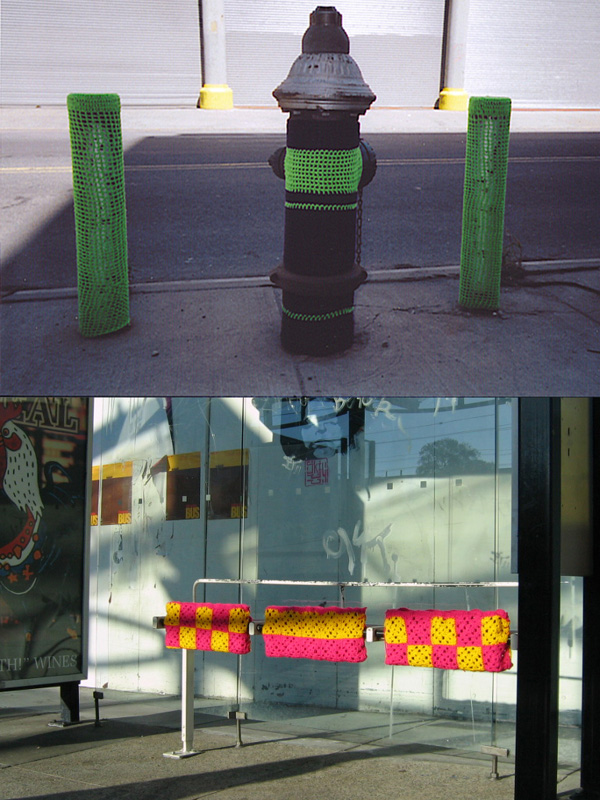|
ERIKA DEFREITAS | ||||||||||||||||||||||||||||||||||||||||||||||||||
| NEWS || CV || PROJECTS || LINKS || CONTACT | ||||||||||||||||||||||||||||||||||||||||||||||||||
Work 2007In the Living Room Series and In the Bedroom Series 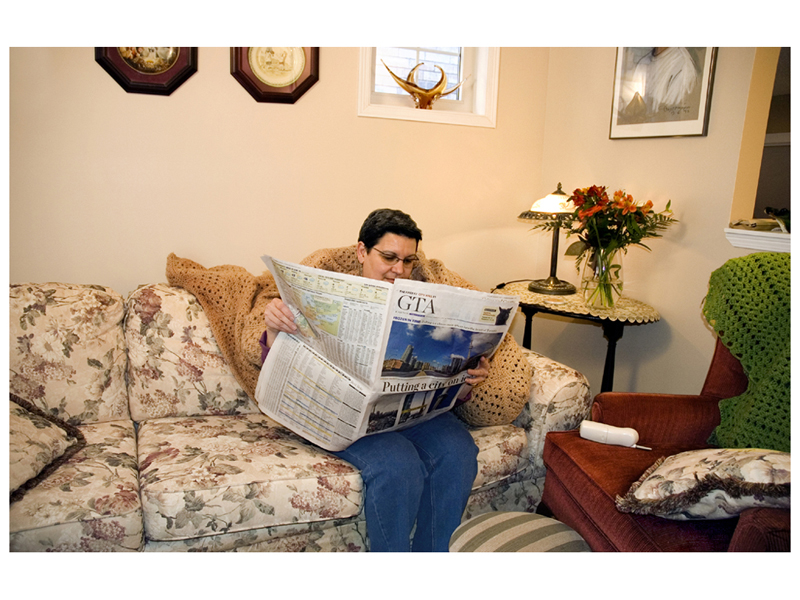
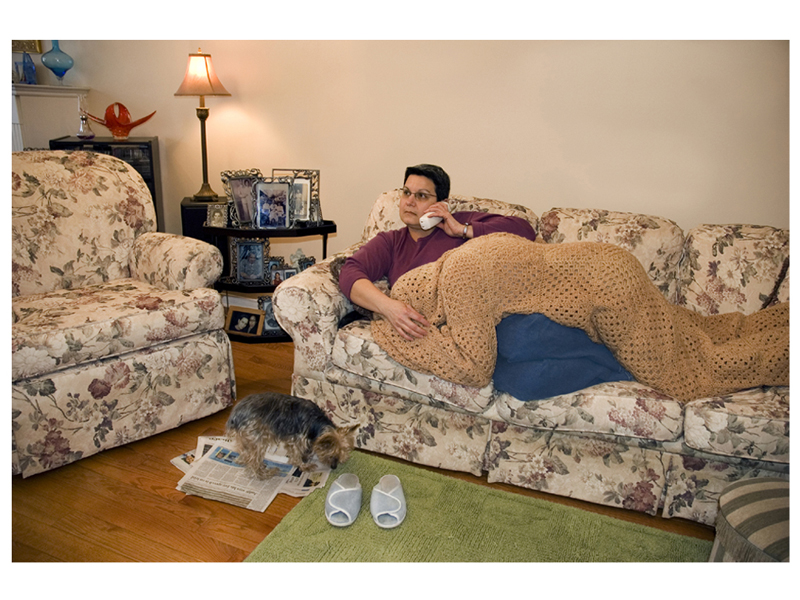
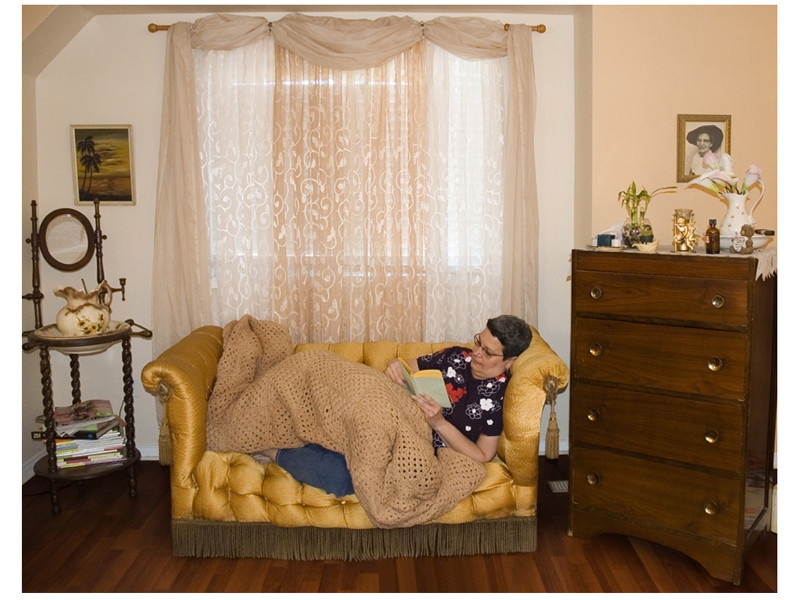
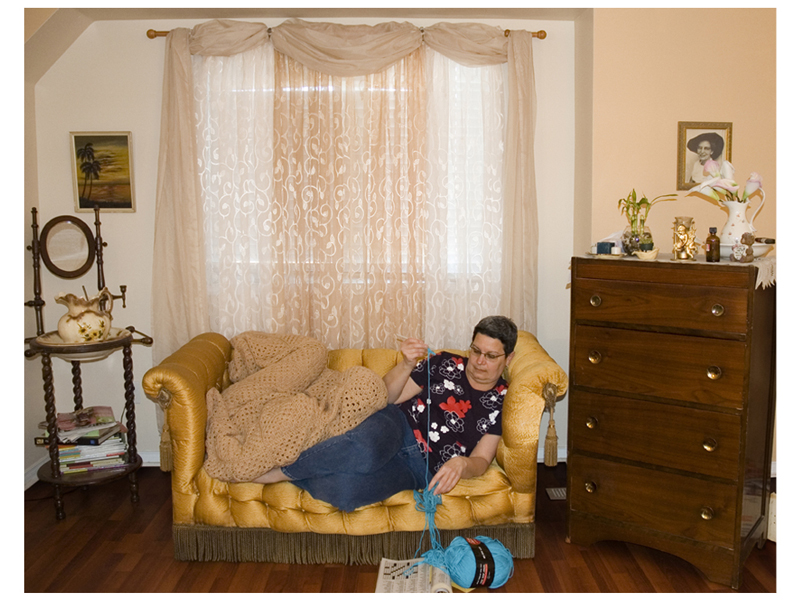
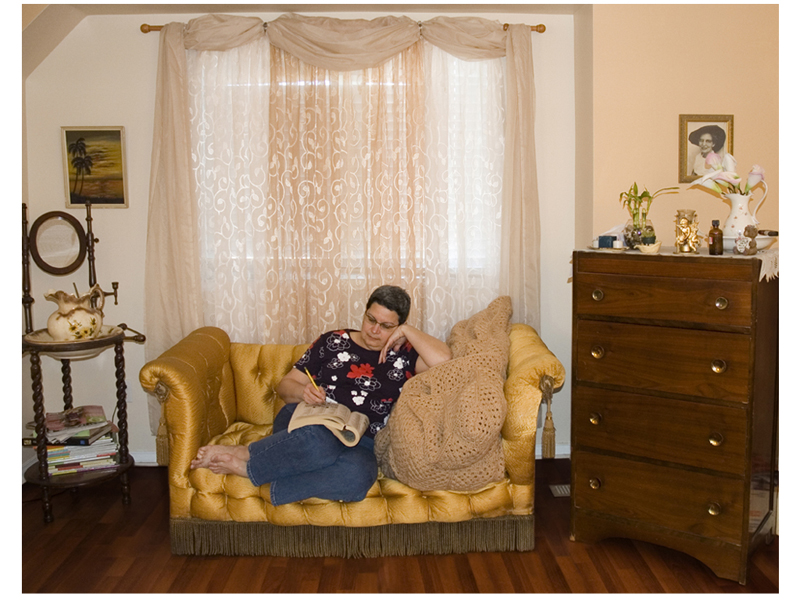
Dear Mom, This is an invitation to design and create a cozy that will cover my entire body. In this bag you are provided with a sketchbook to write your thoughts and sketches, a crochet needle, and five balls of wool. I will be available for measurements as you see fit. If you accept this invitation, I will then become something of comfort for you, as the cozy you will make, will be something of comfort for me.
Sincerely, My recent interest in memory, narrative and absence initiated a collaboration between myself and my mother. I was interested in investigating the dynamics of a mother/daughter relationship through particular actions that challenge notions of absence and presence. I presented the above invitation to my mother, and after a few weeks she crocheted a large cozy made to fit and encapsulate my entire body. Crochet, as a process for creating this cozy was chosen, as it is a skill that has been passed down to generations of women on the matriarchal side of my family. At the completion of its creation, I was sewn into the cozy. While in the domestic space of my mother’s home, as promised, I became something of comfort for her. As a surreal object – somewhat similar to that of a blanket – I was draped around and over my mother as she enjoyed activities in the comfort of her home. Digital photography was used as a way to document these actions. Death, Memorials, Births 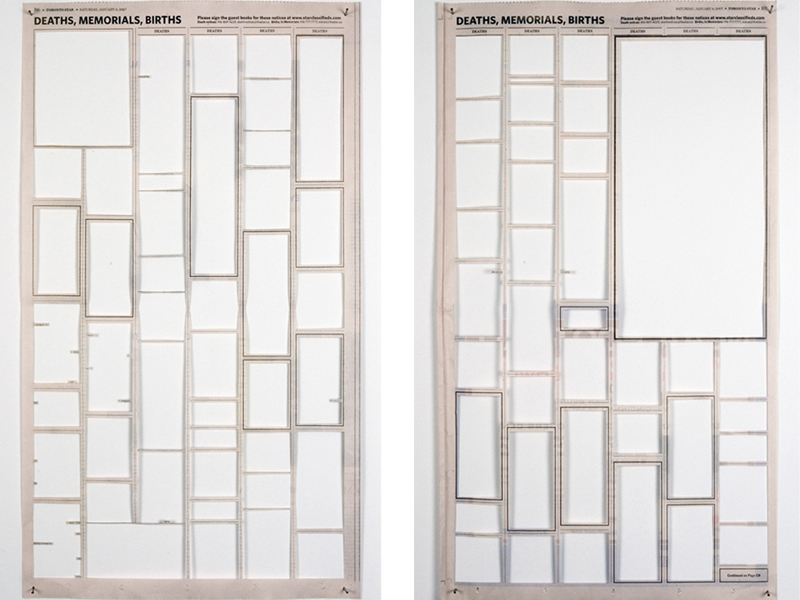
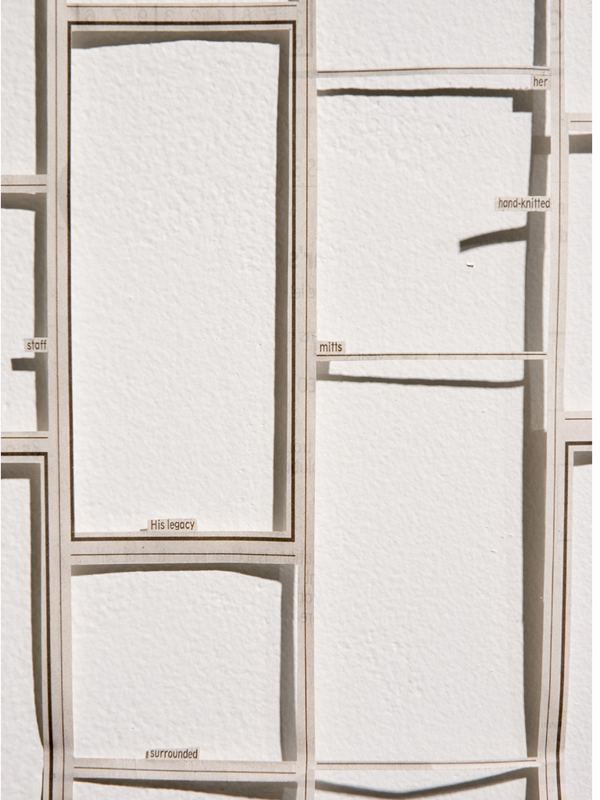
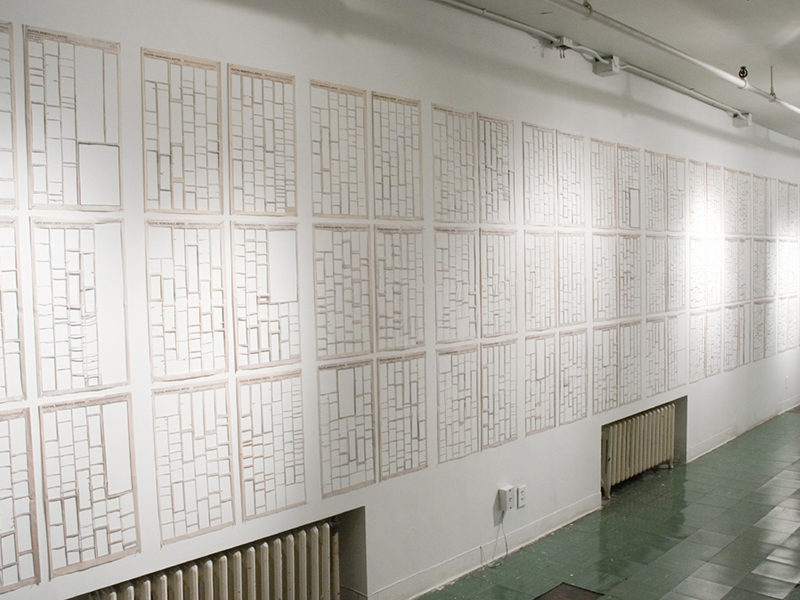
I started collecting the ‘Obituary’ section from the Toronto Star, as they were read by me in November 2006. Reading over the death notices, I began formulating memories. Many of these memories are fabricated - they become constructions of what I imagine past relationships were like, how they are in the present, and how they would be in the future. I kept track of words that resonated with me on each day, by writing them down and nothing what column and row they were located on. Once I completed this process for each day, I would work with those words to create a metaphorical narrative that was representative of the memory that had been created. I cut out all of the death notices - leaving the borders that framed them and the lines that separated them then I took those words that were selected and removed and placed them within the space where they were originally found. The final product of this act is then digitally photographed as a means of questioning authorship, the extent of absence, and the limits of time.
The actual newspaper is essential, as the material speaks to the ephemeral nature of this work. The newspaper, especially as an ‘everyday’ object, acts as the materialization of the passing of time, the negation that has occurred and will continue to occur, and as an indicator of the time that cannot be retracted and replenished. This effect is further emphasized with the date that indicates the day the newspaper was printed, as well as with those that indicate the day of one’s passing. Each date holds a particular place in time and in history.
The notion of the newspaper as an ‘everyday’ object transforms the ‘Obituary’ section into a compelling artifact of both the past and the present. There is a compelling dichotomy that exists within the obituary as an object. With each death notice, which are markers of an individual’s absence, there is an overwhelming sense of presence. I chose to cut out the death notices, because each individual became too ‘present’ and in turn, the work then reflected upon them rather then on the absence I attempt to articulate.
In relation to Deaths, Memorials, Births, the informal ‘collaboration’ between myself, and the original author conceives a third person/mind who is always unaccounted for. This third person/mind is one factor that makes this artwork accessible to others. This displacement of authorship exposes a space where anyone reading these words can appropriate the narrative to conform to personal experience, memory or thought.
Deaths, Memorials, Births is an ongoing, ever growing work. It will continue for as long as I have the ability to remember the past and imagine the future. When installed, the individual pieces that comprise this work take the form of a memorializing structure, both through the actual objects created and the shadows projected on the wall by the sheets themselves. The shadows create a three dimensional component to the work, but also re-enunciates the pace at which the absence grows and spreads from day to day, and month to month. In a sense, the shadows compensate for loss by giving a presence to empty, negative spaces. In a temporary way, they concretize and cast a body that is lost, missing, but never forgotten and never quite remembered. As a body of work displayed on a wall, they create a monumental gesture of grief and of loss. At this point in its creation, this monument functions as a form of remembrance, grief, preservation, tension and trauma.
Pass-port (2) 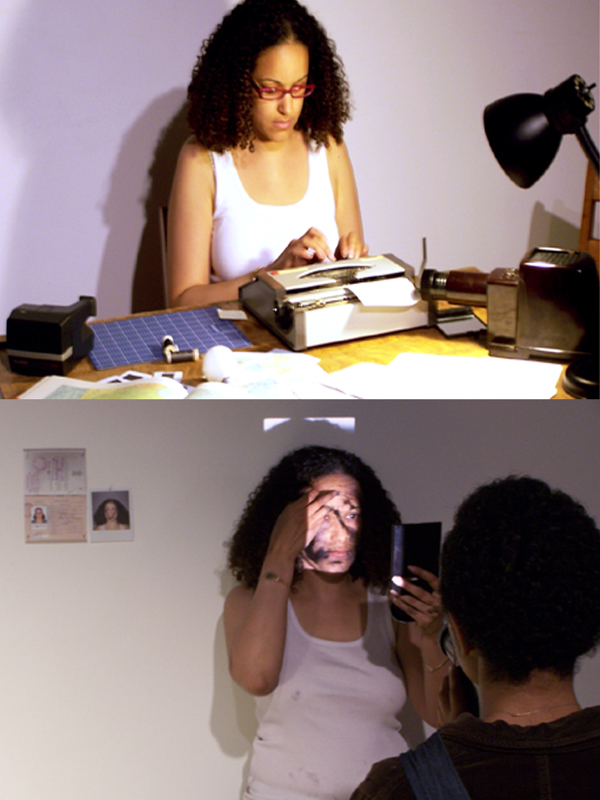
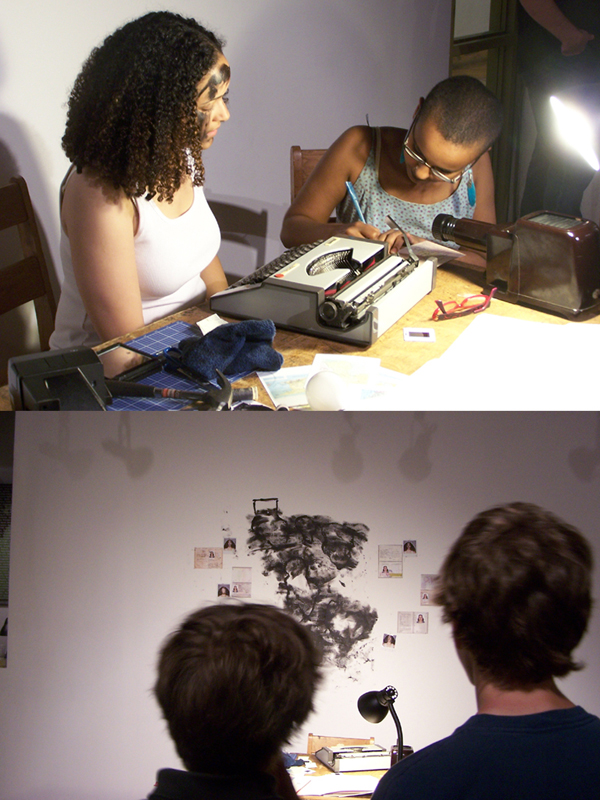
I have experienced on many occasions how easy it is for me, due to my appearance, to ‘pass’ for another nationality. I have never done this ‘passing’ intentionally; rather it has been others who have insisted that I was of a particular nationality. I feel that it is important to share these experiences to demonstrate that although it is possible for me to be accepted within other ethnic groups, this ability to ‘pass’ as another nationality can also cause me to be even more marginalized from the majority in particular situations. This can then evoke in me a greater sense of isolation and a stronger need to belong.
Sitting at a desk, I type fragments of narrative relating to an experience of ‘passing’ onto a pre-made passport for a particular country of ‘passing’. Using a projector, a person in the gallery is asked to project the map of that particular country onto my face. I trace that map on my face. I draw on the wall behind me a copy of that map from memory. I photograph myself. I ask a viewer to sign the passport verifying my identity. This is a crucial aspect as the individual may or may not choose to sign the passport, therefore choosing to affirm or negate my identity. The passport and photograph is hammered into the wall. I wipe the map off my face, leaving remnants of the drawing. I repeat this activity until all stories of ‘passing’ are typed and the corresponding passports are created. To conclude, using my face, I wipe away the hand drawn map on the wall. The passports, photographs, and smeared map remain as artifacts of this process of claiming and being claimed. 2005Break Me Off a Piece of That (Please) 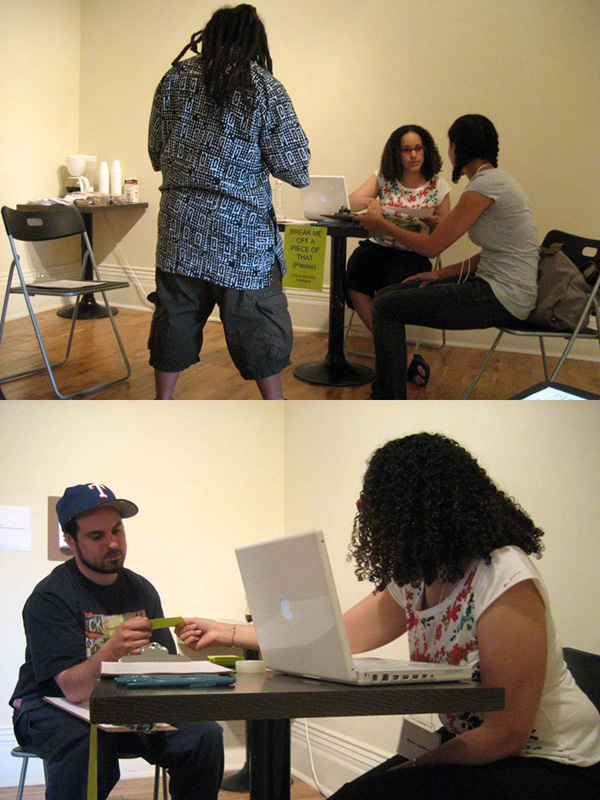
Curatorial Statement written by Milena Placentile
“The Canadian art world is not sustainable, and the causes for this are numerous. Some causes are circumstantial and could change with a different government, but others are much more deeply rooted. The dominant economic model undervalues the time, energy, and expertise involved in the production of art, and the prevalence of opinions that art is trivial, wasteful, or futile make critical dialogue extremely difficult.
DeFreitas has observed how frequently artists are expected to be satisfied with meager compensation, or to donate their time and work. Fundraising auctions exemplify this because they are widely regarded as chances to acquire artwork at below market value. So few artists have expendable time and resources to participate in these events, yet they feel obligated to demonstrate their support for a cause, or they are in need of opportunities to circulate their name and work. Why do we live in a society where it's common to think that art should be cheap, or even free? To draw attention to this issue, and with the aim of turning a dilemma into a positive exchange, DeFreitas has established an agency designed to solicit donations from visiting audiences that are matched to artists in need. It would indeed be wonderful to connect lawyers, accountants, mechanics, and other professionals interested in donating some time and skill to individual artists as a show of support. “ The Snapshot Chronicles 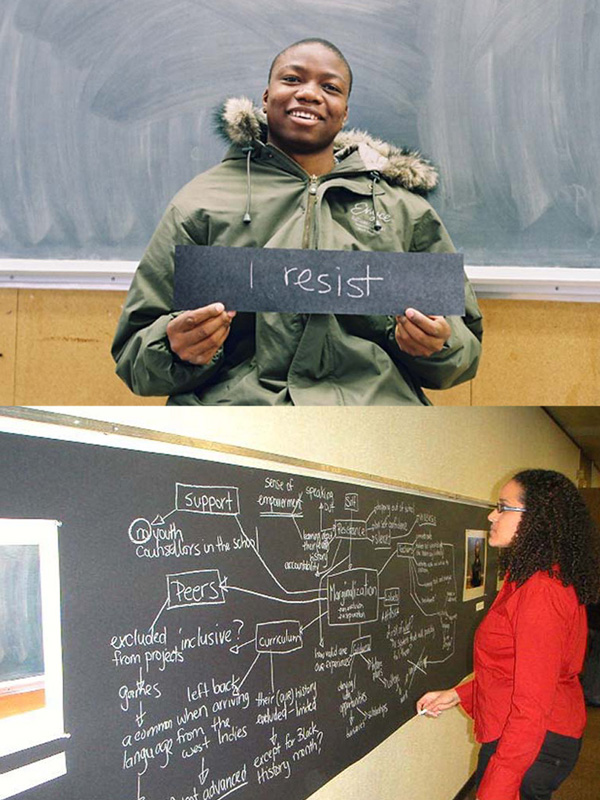
“Our words are not without meaning, they are an action, a resistance.” (hooks, bell) During my years in the public education system, students and teachers subjected me to acts of racism and discrimination on school grounds and in classrooms. These acts resulted in being publicly excluded, but they also led to an internal exclusion, leaving me consumed with anger and loneliness. Seven years after graduating high school and now working in one, I see that students are still subjected to similar treatment. Many youth have embraced being “voiceless”, and see that there is use in talking about these situations because nothing would come from it, or no one would listen. One year ago, I started working with some of these youth, facilitating lessons on black history and culture, and media representations of “blackness”. They are increasing their awareness of how to identify racism and discrimination – what they “sound” like, what they “feel” like, and what they “look” like.
The Snapshot Chronicles uses the setup of a school “picture day” to create a narrative where black youth can document their personal experiences of marginalisation within the public education system. The purpose is to provide a platform for these youth to chronicle their journeys, to know that they have a ‘voice’, their experiences are valid, and that people will listen. They are using their experiences of marginalisation as a site of resistance, rather then one of oppression and isolation. In addition to youth who are currently in a secondary school in Toronto, those who have already gone through the system have been invited to take part in this installation.
2004Through the Lens Series 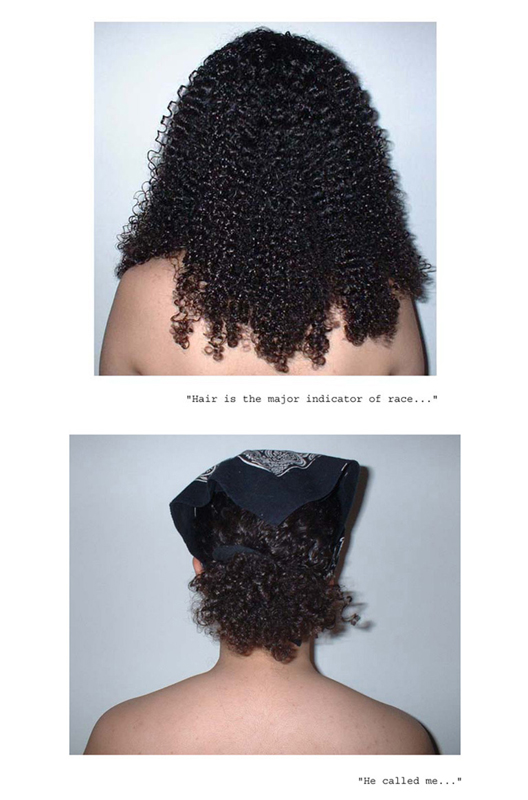
For this project, I wanted to appropriate Carrie Mae Weems use of photographic image and text to create dialogue around race and representation, more specifically the perpetuation of racial stereotypes based on my skin and hair. I wanted to raise questions about our perceptions of ‘blackness’ through the use of my body. In these photographs, my body becomes a site of projected questions, assumptions, and stereotypes.
Sticks and Stones 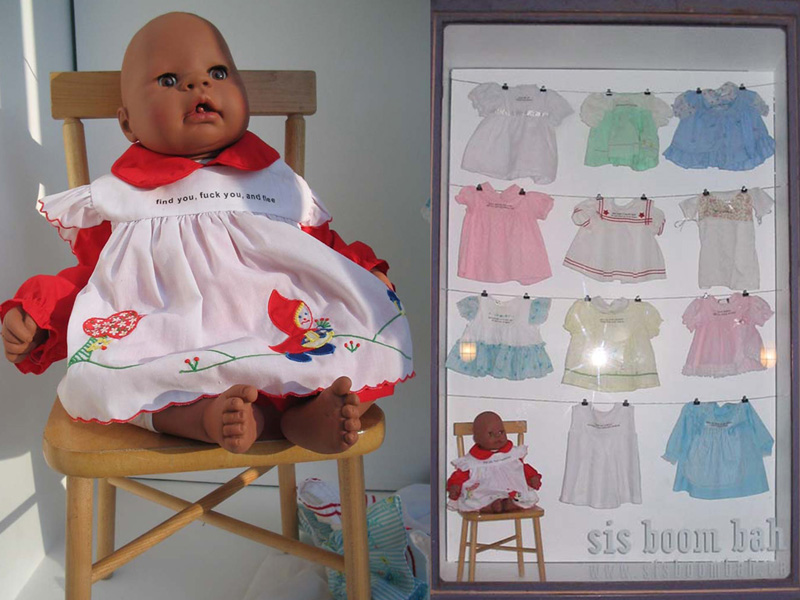
I have become engaged in the act of deconstructive listening, as well as textual decoding of lyrics that have been written and performed by hip-hop emcees. My standpoint as a female grappling with post-modern feminist ideology has been essential to this process of identifying and deconstructing lyrics that degrade and objectify women. It is my belief that these lyrics transcend the obvious interpretation, and that meaning emerges from a dialogical relationship between the author and intended audience. I am particularly interested in how patriarchal ideologies, dichotomies, and objectifications are embedded in these lyrics and work as tools that aid in the marginalization of women. I am exploring how the hip-hop archetypes of ‘the bitch’, and ‘the hoe’ emerge from this oral tradition, and become dominant scripts to be played out.
This project is at once a commentary on what we have chosen to accept as a part of hip-hop culture; a culture that has a strong presence in our greater society. As well, it is my act of resistance through acknowledgement, a process of deconstruction, and a growing awareness of the use and power of language.
2003Untitled (Otherself) 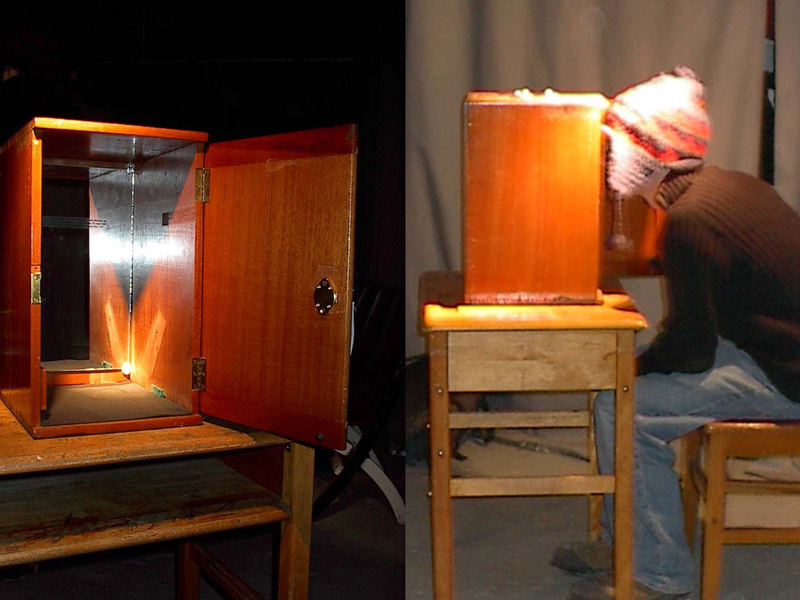
For the duration of this performance I will engage in small, one-on-one conversations with approximately 30 randomly chosen people in the gallery. At the end of our conversation I will shake the individual’s hand. It is during this handshake that I will transfer a key from my hand to their hand and promptly leave their presence. Attached to this small key is a note that states:
There are no instructions given with the key. Each key opens the door to a wooden box that sits on a desk in the corner of the gallery. The front of the box reads:
Open the door. Please lock the door when you are finished. Do not give the key to anyone else. The key is yours to keep. When the door to this box is opened the individual is confronted by their reflection in a mirror that has the following text written on it:
The mirror acts as a tool to project upon the viewer not only an image of ‘self’ but also an image of ‘self’ as the ‘other’. As a female and a visible minority there is sense of discreet confrontation in me asking the majority to question their identity and increase the awareness of the possibility that one’s identity is shaped by someone else. This performance puts into question our process of deconstructing and understanding the formation of our identity, specifically by deconstructing the identity of the ‘other’.
* Said, Edward. Orientalism. Vintage: 1979.
Untitled (Graffiti) 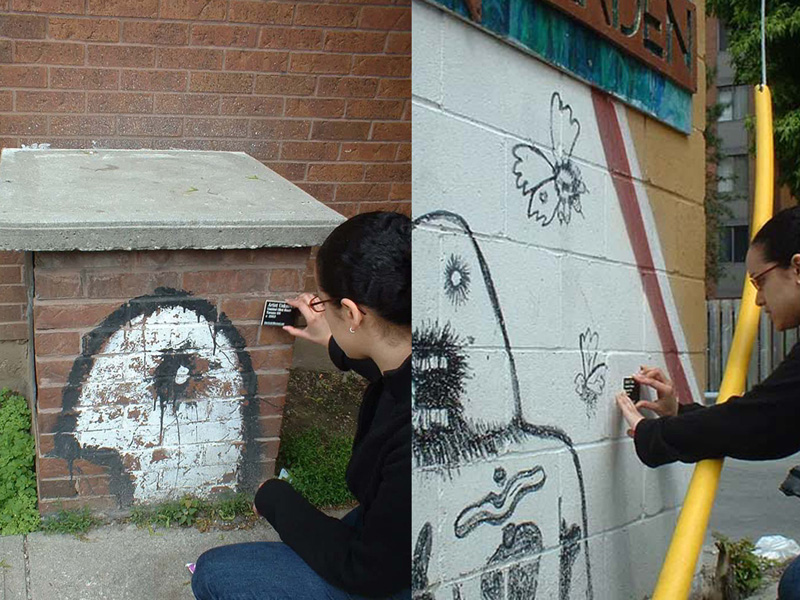
If graffiti were looked at as art rather than deformation of property, would the general public and authority figures be so concerned to remove it? The Graffiti Eradication Program created by the Toronto police in the summer of 2000 has a mission, which is to “decrease the crime, fear and disorder that the presence of graffiti brings to our streets”. Not all graffiti evokes fear, nor was that the intention of many graffiti artists. I believe that a lot of the fear occurs due to the spontaneity of the work and the anonymity of the artist. Generally, in an art gallery, a ‘tag’ that provides information about the piece and acknowledges the artist accompanies a work of art. My intention is to alter a specific site that contains graffiti, by placing something in it to change the context in which the graffiti is seen. I will select particular graffiti pieces throughout Toronto that make no reference to hate crimes, nor are gang related, and prepare a ‘tag’ specific to each piece to be attached to the site. This ‘tag’ will contain information about the piece of work; it will however, only serve as a minor intrusion to the space, because it will only be noticed if approached by someone for closer inspection. The ‘tag’ enforces the art aspect of the graffiti, creating a sense of authenticity, and it also lends to the space a sense of institutional significance and importance. The ‘tag’ legitimized the graffiti as art, giving the work and artist acknowledgement. Something Pretty Cozy 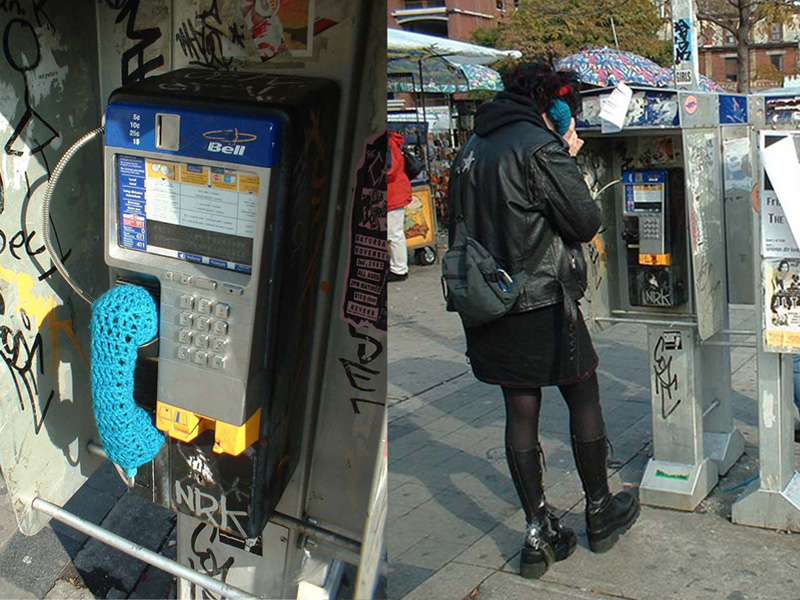
“…to think imaginatively about space, about the link between what we desire, dream about, and what is practical.” bell hooks Sitting in my mother’s living room one night, I looked around at the objects that occupied the space. I noticed that there lacked decorative embellishments. The decorative elements are essentially minimal except for the crocheted mats, tablecloths, and blankets. These hand made objects are projects made by the women in my family for over four generations. These items make the home feel warm and complete. I spent some time looking at these objects and realized that I never really appreciated the role they played in making my mother’s house a home of comfort and familiarity. With this in mind, I also realized that I rarely spent time at home and that most of my time was spent travelling via public transportation or by foot throughout Toronto. It was with this understanding that I became interested in shaping and constructing environments through small interventions by transferring this decorative aspect of my home to the street. I wanted to give ‘cold’, random objects a sense of warmth, aesthetic purpose, and in an odd way, give the street a sense of homeliness. By transferring this family tradition of crocheting from my house to objects on the street, I am taking something out of its normal environment and placing it in an unfamiliar surrounding. This makes the space a place of familiarity. Perhaps those who come into contact with the objects will consider steps that they could take to beautify the city, to make it a place of comfort and familiarity instead of a place of cold concrete and ambiguity. (Untitled) Book Piece 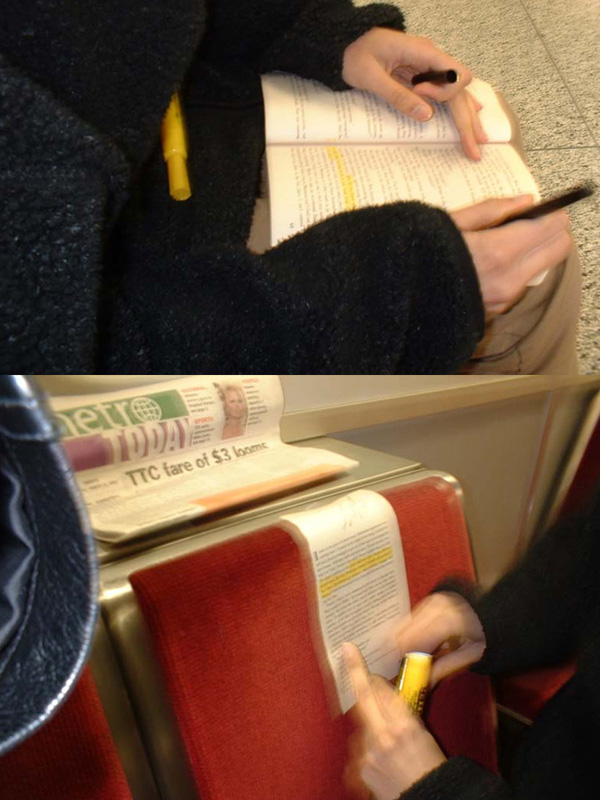
For this intervention, I read White Noise by Don DeLillo during my daily travels on Toronto public transportation. This novel was chosen due to the pacing of the text and its similarity to the pace of my journey. Furthermore, the themes embedded in this novel held a significant relationship to the act of reading on public transportation as a daily ritual, and more importantly to the space of public transportation as a site of vulnerability in relation to what we are given to read (free newspapers, advertisements, etc…) and to other commuters, which stems from the aftermath of 9-11 in New York City.
“ In White Noise in particular, I tried to find a kind of radiance in dailiness. Sometimes this radiance can be almost frightening. Other times it can be almost holy or sacred…Our sense of fear – we avoid it because we feel it so deeply, so there is an intense conflict at work…” If a particular aspect of this text appeared to be relevant to the nature of this intervention, I highlighted that line, sentence, or paragraph; on the top of the page I wrote the time, date, and place. Then I ripped out the page and taped it to wherever I was at that moment. My intention for those who read the highlighted section, was that by acknowledging the page and perhaps even questioning its relevance, there may have been a questioning of the other text in their surrounding environment, and how it influences who they are and those around them. 2002Eaves Droppin' 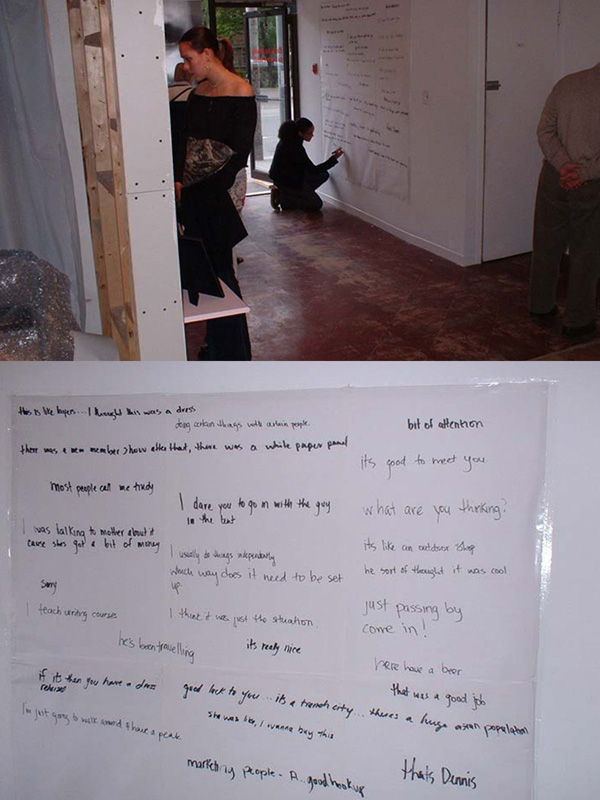
I am interested in communication. In particular, I am interested in the changes it undergoes when processed through various filters. I would like to explore this by appropriating the dialogue of others. I will casually walk around the gallery space listening to the conversations that people in the gallery are engaged in. When I am able to capture a fragment of conversation, I will write with a marker what I have heard, using the wall as a writing surface. This process of recording the conversation of others will occur for approximately 30 minutes (depending on the activity within the gallery). In doing so, the audience becomes a participant without being aware. I will then begin to arrange the fragments of conversation into my own narrative. When this is complete, I will recite what I have written. I now will be engaging in a dialogue with those in the gallery. The objective and final outcome of this performance will be me communicating with others, a story through the use of their words. This brings into question not only the authenticity of my reconstructed narrative, but also the narratives of the original speaker(s). Due to the process of appropriating dialogue, there is a sense of displacement of narrative from the original speaker and the original context in which it was said and heard. This displacement is further emphasized when it is acknowledged that the chosen dialogue is manipulated to suit the needs of another speaker. Although this occurs, the final outcome formulates a connectedness amongst the fragmented dialogue, to create a narrative that speaks of process, ownership, and space. |
